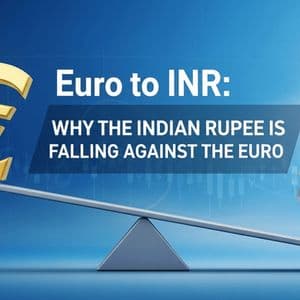BitcoinWorld Euro to INR: Why the Indian Rupee is Falling Against the Euro As of September 25, 2025 , the exchange rate for one Euro (EUR) is approximately 104.215 Indian Rupees (INR) . The value of the INR has been steadily falling against the EUR , a trend that reflects a complex interplay of global economic conditions, domestic Indian policies, and broader geopolitical 0 depreciation, while a concern for importers and Indian citizens living in the Eurozone, is a natural outcome of several key factors influencing the supply and demand for both 1 is the Indian Rupee (INR) Continually Falling Against the Euro (EUR)? The depreciation of the Indian Rupee is not a result of a single issue but a combination of long-term structural challenges and immediate market 2 these factors is crucial for anyone monitoring the EUR to INR exchange rate.
India’s Trade Deficit: A primary driver of the INR’s weakness is India’s persistent trade deficit, particularly its high reliance on imports. A significant portion of this is attributed to crude oil, which requires India to spend substantial amounts of foreign 3 imports exceed exports, the demand for foreign currency (like the EUR ) increases, putting downward pressure on the 4 Capital Outflows: The INR is highly sensitive to the flow of foreign 5 2025 , persistent outflows of foreign institutional investments (FII) from the Indian market, often in response to global uncertainties or more attractive opportunities elsewhere, have reduced the demand for the Rupee and contributed to its 6 Policy Differences: The monetary policies of the Reserve Bank of India (RBI) and the European Central Bank (ECB) play a crucial 7 in interest rates and approaches to managing inflation and money supply can make one currency more appealing to investors than the 8 Economic Headwinds: Broader global factors, such as geopolitical tensions and shifts in global trade policies, can severely impact investor 9 example, the imposition of new tariffs by countries like the 10 raised concerns for India’s economy and has been a major contributor to capital outflows and Rupee 11 Inflation: If inflation is higher in India than in the Eurozone, the purchasing power of the Rupee erodes 12 makes goods and services in India relatively more expensive compared to those in the Eurozone, leading to a depreciation of the INR in the long 13 is the Impact of a Weaker Indian Rupee?
A depreciating Indian Rupee has a dual impact on the economy, creating both challenges and opportunities. Challenges: A weaker INR makes essential imports, such as crude oil and electronics, more 14 can lead to cost-push inflation , raising the prices of consumer goods and 15 Indian students studying in Europe or families with loved ones there, it also increases the cost of remittances and tuition fees. Opportunities: On the flip side, a weaker Rupee makes Indian exports more competitive in the global 16 goods and services become cheaper for European buyers, which can help improve the country’s trade balance and boost export-oriented sectors like textiles, software services, and 17 is the INR falling against the USD as well as the EUR?
The INR has been under pressure against multiple major currencies, including both the USD and the 18 widespread depreciation is primarily due to global factors that are influencing all emerging market currencies. A strengthening U. S. dollar, driven by factors like interest rate expectations, has led to capital moving out of emerging markets and into 19 creates a domino effect, weakening currencies like the INR not only against the USD but also against other major currencies like the 20 does the Reserve Bank of India (RBI) manage the INR’s value?
The Reserve Bank of India (RBI) intervenes in the foreign exchange market to manage the INR’s value and prevent excessive 21 RBI does not target a specific exchange rate but aims to ensure orderly market 22 achieves this by buying or selling foreign currency reserves, like the 23 , to either strengthen or weaken the Rupee as needed. However, its interventions are often limited to smoothing out sharp moves and do not typically reverse long-term 24 a falling INR always indicate a weak Indian economy? No, a falling INR does not always indicate a weak Indian 25 depreciation can reflect certain challenges like trade deficits or capital outflows, it can also be a healthy adjustment that makes a country’s exports more 26 fact, many economists argue that a certain level of depreciation is necessary for an export-driven economy.
Therefore, the value of the Rupee is just one of many indicators, and it must be considered alongside other economic data points, such as GDP growth , inflation, and fiscal 27 The current exchange rate of the Euro to INR and the ongoing depreciation of the Indian Rupee are the result of powerful economic 28 short-term volatility is always present, the long-term trend is driven by fundamental factors like India’s trade balance, foreign investment flows, and the relative monetary policies of the RBI and 29 the global economy continues to navigate geopolitical and trade uncertainties, the INR’s value will remain a key indicator of India’s economic health and its ability to manage these external 30 post Euro to INR: Why the Indian Rupee is Falling Against the Euro first appeared on BitcoinWorld .
Story Tags

Latest news and analysis from Bitcoin World



